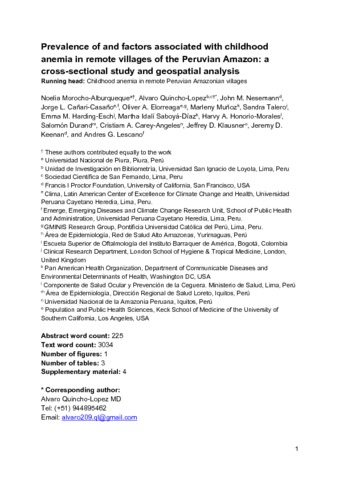Prevalence of and factors associated with childhood anaemia in remote villages of the Peruvian Amazon: a cross-sectional study and geospatial analysis.
 ; Nesemann, JM; Cañari-Casaño, JL; Elorreaga, OA; Muñoz, M; Talero, S; Harding-Esch, EM
; Nesemann, JM; Cañari-Casaño, JL; Elorreaga, OA; Muñoz, M; Talero, S; Harding-Esch, EM ; Saboyá-Díaz, MI; Honorio-Morales, HA; +5 more...Durand, S; Carey-Angeles, CA; Klausner, JD; Keenan, JD; Lescano, AG and
(2023)
Prevalence of and factors associated with childhood anaemia in remote villages of the Peruvian Amazon: a cross-sectional study and geospatial analysis.
Transactions of the Royal Society of Tropical Medicine and Hygiene, 117 (8).
pp. 598-605.
ISSN 0035-9203
DOI: 10.1093/trstmh/trad018
; Saboyá-Díaz, MI; Honorio-Morales, HA; +5 more...Durand, S; Carey-Angeles, CA; Klausner, JD; Keenan, JD; Lescano, AG and
(2023)
Prevalence of and factors associated with childhood anaemia in remote villages of the Peruvian Amazon: a cross-sectional study and geospatial analysis.
Transactions of the Royal Society of Tropical Medicine and Hygiene, 117 (8).
pp. 598-605.
ISSN 0035-9203
DOI: 10.1093/trstmh/trad018
BACKGROUND: Anaemia is a public health problem in Peru. In the Loreto region of the Amazon, ≥50% of children may be anaemic, although insufficient information exists for rural villages. METHODS: To generate more data about childhood anaemia in the Peruvian Amazon, haemoglobin was measured as part of a trachoma survey in 21 randomly selected villages. All children 1-9 y of age from 30 randomly selected households per village were recruited. Anaemia was classified according to the World Health Organization guidelines and a socio-economic status (SES) index was created for each household using principal component analysis. Spatial autocorrelation was determined using Moran's I and Ripley's K function. RESULTS: Of 678 children with complete haemoglobin data, 25.4% (95% confidence interval [CI] 21.2 to 30.1) had mild-or-worse anaemia and 22.1% (95% CI 15.6 to 30.3) had moderate-or-worse anaemia. Mild-or-worse anaemia was more common among children whose primary source of drinking water was surface water (prevalence ratio [PR] 1.26 [95% CI 1.14 to 1.40], p<0.001) and who were in the lowest SES tercile (PR 1.16 [95% CI 1.02 to 1.32], p=0.021). Moderate-or-worse anaemia was more common among boys (PR 1.32 [95% CI 1.09 to 1.60], p=0.005). No evidence of geospatial clustering was found. CONCLUSIONS: Remote villages of the Amazon would benefit from interventions for childhood anaemia and the poorest households would have the most to gain. Integrating anaemia screening into neglected tropical diseases surveys is an opportunity to use public health resources more efficiently.
| Item Type | Article |
|---|---|
| Elements ID | 207823 |
| Official URL | https://doi.org/10.1093/trstmh/trad018 |
| Date Deposited | 16 Dec 2024 09:45 |

-
picture_as_pdf - Prevalence-of-and-factors-associated-with-childhood-anemia-in-remote-villages-of-the-Peruvian-Amazon.pdf
-
subject - Accepted Version
-
error - This is an author accepted manuscript version of an article accepted for publication, and following peer review. Please be aware that minor differences may exist between this version and the final version if you wish to cite from it.
-
copyright - Available under Copyright the publishers